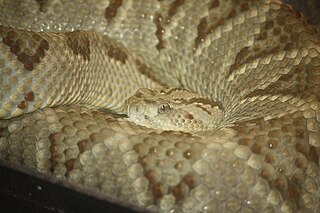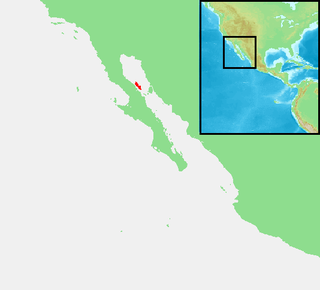
Crotalus stephensi is a venomous pitviper species found in central and southern Nevada and adjacent California. Common names include panamint rattlesnake, panamint rattler, Owens Valley rattler, and tiger rattlesnake.

The black-tailed rattlesnake is a venomous pit viper species found in the southwestern United States and Mexico. Four subspecies are currently recognized, including the nominate subspecies described here.

Crotalus basiliscus is a species of venomous pit viper in the family Viperidae. The species is endemic to western Mexico. The specific name, basiliscus, is derived from the Greek word for king, βασιλισκος, and alludes to this snake's large size and potent venom. No subspecies are currently recognized.

Crotalus willardi is a venomous pit viper species found in the southwestern United States and Mexico. This snake is found mainly in the "sky island" region. The IUCN reports this snake's conservation status as being of Least Concern. It is the official state reptile of Arizona.

Crotalus ruber is a venomous pit viper species found in southwestern California in the United States and Baja California in Mexico. Three subspecies are currently recognized, including the nominate subspecies described here.

Crotalus mitchellii is a venomous pit viper species in the family Viperidae. The species is endemic to the Southwestern United States and adjacent northern Mexico. The species was named in honor of Silas Weir Mitchell (1829–1914), an American medical doctor who also studied rattlesnake venoms. Five subspecies are currently recognized, including the nominate subspecies described here.

The Santa Catalina rattlesnake is a species of venomous pit viper endemic to Isla Santa Catalina in the Gulf of California just off the east coast of the state of Baja California Sur, Mexico. No subspecies are currently recognized. A relatively small and slender species, its most distinctive characteristic is that it lacks a rattle.

Crotalus enyo is a venomous pit viper species native to the coast and islands of northwestern Mexico. Three subspecies are currently recognized, including the nominate subspecies described here.

Crotalus ravus, commonly known as the Mexican pigmy rattlesnake or Mexican pygmy rattlesnake, is a venomous pit viper species, found only in Mexico. Three subspecies are currently recognized.

Crotalus simus is a venomous pit viper species found in Mexico and Central America. The specific epithet is Latin for "flat-nosed", likely because its head is blunt compared with lanceheads (Bothrops). Three subspecies are recognized, including the nominate subspecies described here.

Crotalus oreganus, commonly known as the (northern) Pacific rattlesnake, is a venomous pit viper species found in western North America from the Baja California Peninsula to the southern interior of British Columbia.

Crotalus atrox tortugensis is a venomous pit viper subspecies found only on Tortuga Island in the Gulf of California.

Crotalus aquilus is a venomous pit viper species found in the highlands of central Mexico. No subspecies is currently recognized. The specific name, aquilus, is Latin for "eagle" and refers to the high altitude at which this species is found.

Crotalus intermedius is a venomous pit viper species found in central and southern Mexico. Three subspecies are currently recognized, including the nominate subspecies described here.

Crotalus pricei is a species of venomous snake, a pit viper in the family Viperidae. The species is endemic to the southwestern United States and northern Mexico. Two subspecies are recognized.

Crotalus pusillus is a venomous pit viper species found in west-central Mexico. No subspecies is currently recognized.

Crotalus angelensis, or the Ángel de la Guarda Island speckled rattlesnake, is a venomous pitviper species endemic to Isla Ángel de la Guarda in the Gulf of California, Mexico. It is sometimes treated as a subspecies of Crotalus mitchellii.

Crotalus oreganus caliginis is a venomous pit viper subspecies endemic to South Coronado Island, Mexico.

Crotalus estebanensis is a venomous pit viper species endemic to San Estéban Island, Mexico.
Crotalus lorenzoensis is a species of pitviper, a venomous snake in the subfamily Crotalinae of the family Viperidae. The species is endemic to San Lorenzo Sur Island, Mexico.



















